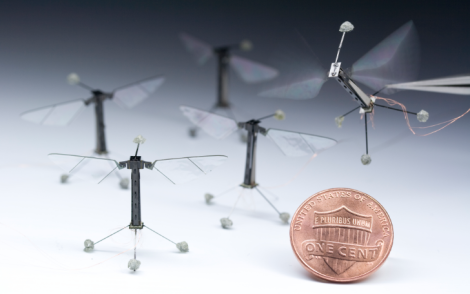They finally made a robot the size of a fly and it actually flies… Run.
Look at this beauty, its translucent wings flap a frantic 120 times per second.

Meet RoboBee. Harvard scientists have been working for a decade on the design, inspired by the biology of a fly, it’s another step forward along two important tracks in robotics, as engineers try to miniaturize their flying machines and model them on living creatures.
Harvard’s School of Engineering and Applied Sciences unveiled a video of the RoboBee’s first controlled flight, watch it below and we’ll talk more…
Conventional robotic designs that rely on electromagnetic motors can’t really work with sub-millimeter-scale anatomy. To make RoboBee fly, Harvard scientists had to work with strips of ceramic that expand and contract when in contact with an electric field, named piezoelectric actuators. Also, the little guy cannot work on its own yet, the tether you see emerging from the RoboBee’s carbon fiber frame is a connection to an external power source, which is impractical for real-world applications.
“Flies perform some of the most amazing aerobatics in nature using only tiny brains,” said Sawyer B. Fuller, a postdoctoral researcher who contributes to the project. “Their capabilities exceed what we can do with our robot, so we would like to understand their biology better and apply it to our own work.”
RoboBee looks perfect for missions like environmental monitoring or search-and-rescue operations. And aye, I know what you’re thinking, the little guy is the perfect spy. Interestingly enough, so far, the U.S. military isn’t involved in the project.Or at least they want us to think so. But the Air Force already designs miniature, experimental surveillance drones whose designs are inspired by birds and bugs.
The manufacturers set high expectations for the next phases of the RoboBee project. It’s a “computationally efficient brain” mounted on the robot to direct the Bee.
N.

